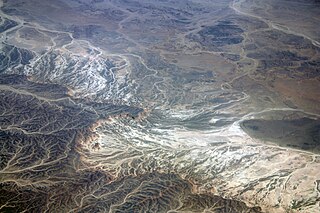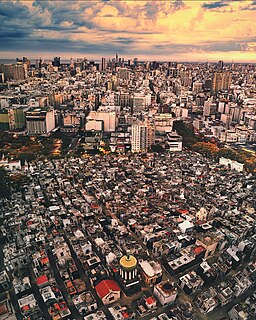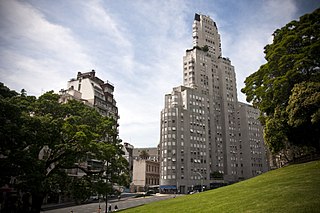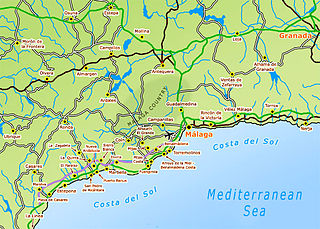| Rio Guadalmina | |
| River | |
Mouth of the Guadalmina River between Marbella and Estepona | |
| Country | Spain |
|---|---|
| Source | |
| - location | Igualeja, Sierra Bermeja , Spain |
| Mouth | |
| - location | Mediterranean Sea, Málaga , Spain |
| - elevation | 0 m (0 ft) |
| - coordinates | 36°27′36″N5°0′19″W / 36.46000°N 5.00528°W Coordinates: 36°27′36″N5°0′19″W / 36.46000°N 5.00528°W |
| Length | 28 km (17 mi) |
The river Guadalmina (from the Arabic for "Wadi (river) of the port") is a short coastal river of the Mediterranean basin in southern Spain that runs entirely within the Andalusian province of Málaga.

Wadi, alternatively wād, is the Arabic term traditionally referring to a valley. In some instances, it may refer to a dry (ephemeral) riverbed that contains water only when heavy rain occurs.

Andalusia is an autonomous community in southern Spain. It is the most populous, and the second largest autonomous community in the country. The Andalusian autonomous community is officially recognised as a "historical nationality". The territory is divided into eight provinces: Almería, Cádiz, Córdoba, Granada, Huelva, Jaén, Málaga and Seville. Its capital is the city of Seville.

The Province of Málaga is located on the southern mediterranean coast of Spain, in Andalusia. It is bordered by the Mediterranean Sea to the south and by the provinces of Cádiz, Seville, Córdoba, and Granada (clockwise).
Only 28 kilometres (17 mi) in length, the Guadalmina rises in the Sierra Bermeja, in the municipality of Igualeja, but its main course begins below the mountains in the municipality of Benahavís, forming a karst aquifer in an area known as Las Angosturas (the narrows). [1] [2] The river flows into the municipality of Marbella near San Pedro de Alcántara, and serves to delimit its border from that of the municipality of Estepona.

Igualeja is a town and municipality in the province of Málaga, part of the autonomous community of Andalusia in southern Spain. It is situated in the west of province in Valle del Genal. It belongs to the comarca of Serranía de Ronda. The municipality is situated approximately 20 kilometers from Ronda and 142 kilometres from the city of Málaga. It has a population of approximately 1,000 residents.

Benahavís is a Spanish mountain village between Marbella, Estepona, and Ronda, 7 kilometers from the coast.

Karst is a topography formed from the dissolution of soluble rocks such as limestone, dolomite, and gypsum. It is characterized by underground drainage systems with sinkholes and caves. It has also been documented for more weathering-resistant rocks, such as quartzite, given the right conditions. Subterranean drainage may limit surface water, with few to no rivers or lakes. However, in regions where the dissolved bedrock is covered or confined by one or more superimposed non-soluble rock strata, distinctive karst features may occur only at subsurface levels and be totally missing above ground.
The Guadalmina was formerly of defensive strategic importance for the people of Marbella; its waters also served to power watermills for grinding grain into flour. The La Concepción reservoir is the primary water source for this municipality; it is formed by a diversion dam on the Río Verde, where the waters of the rivers Guadalmina, Guadalmansa and Guadaiza join and are captured, [3] then transported to provide the water supply of the Costa del Sol towns of Benalmadena, Fuengirola, Mijas, Benahavís, Marbella, Casares and Manilva.

A watermill or water mill is a mill that uses hydropower. It is a structure that uses a water wheel or water turbine to drive a mechanical process such as milling (grinding), rolling, or hammering. Such processes are needed in the production of many material goods, including flour, lumber, paper, textiles, and many metal products. These watermills may comprise gristmills, sawmills, paper mills, textile mills, hammermills, trip hammering mills, rolling mills, wire drawing mills.

Fuengirola, in ancient times known as Suel and then Suhayl, is a large town and municipality on the Costa del Sol in the province of Málaga in the autonomous community of Andalusia in southern Spain. It is located on the central coast of the province and integrated into the region of the Costa del Sol and the Commonwealth of Municipalities of the Costa del Sol Occidental.

Mijas is a town and municipality in the Province of Málaga, in the autonomous community of Andalusia. Located on the South-Eastern coast of Spain, Mijas belongs to the region of Costa del Sol Occidental. Its centre is a typical Andalusian white-washed village, located on a mountainside about 430 metres or 1,476 feet above sea level, in the heart of the Costa del Sol region.

The lower course of the river is heavily urbanized; many homes there have a high risk of inundation. [4] [5]
Near the river's mouth, next to San Pedro de Alcántara, are the important archaeological sites of the early 4th-century Christian church Basílica de Vega del Mar , the 3rd-century vaulted Roman baths of Las Bóvedas (the Domes) and the eponymous watch tower of Torre de Las Bóvedas. [6]
The Basílica de Vega del Mar is a church in Marbella, southern Spain. This is one of the few examples of North African Visigothic churches built in Andalusia during sixth century. It is located near the mouth of the Guadalmina River along an old Roman road which connected Cadiz with Cartagena.


















